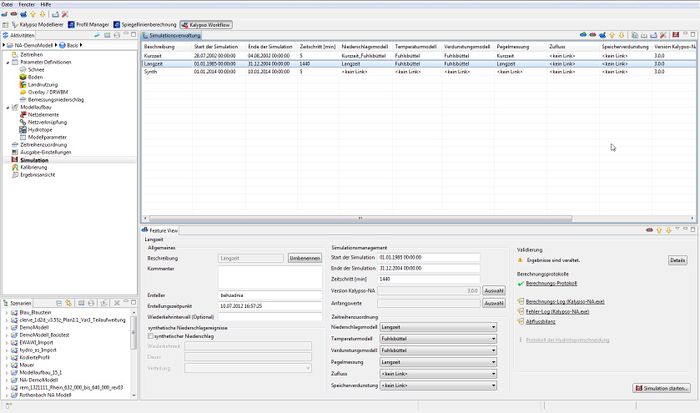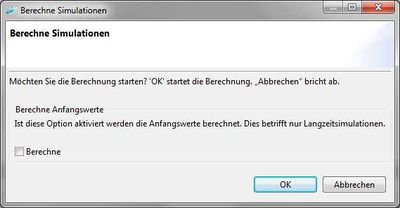Difference between revisions of "Simulation/hydrology/en"
BhawaniRegmi (Talk | contribs) (Created page with "== Execution of Simulation == An dieser Stelle werden die Rechenvarianten erstellt. <br /> Unter der ''Simulationsverwaltung'' können verschiedene Berechnungseinstellungen v...") |
BhawaniRegmi (Talk | contribs) (→Execution of Simulation) |
||
| Line 1: | Line 1: | ||
== Execution of Simulation == | == Execution of Simulation == | ||
| − | + | At this point, the computing variants are created. | |
<br /> | <br /> | ||
| − | + | Under the ''Simulation Management'' different calculation settings can be defined. At this point a distinction is done between the calculations with synthetic precipitation events (KOSTRA data) or Time Series Area Models (measured Time Series). A computing variant can be used for calibration, calculation of scenarios, as well as for the event calculation. Generally, a long and short term simulation is distinguished. When calculating with measured time series,[[Simulation/Langzeitrechenvariante/hydrology/de|''Long term'']]- und [[Simulation/Kurzzeitrechenvariante/hydrology/de|''Short term simulation'']] a long term simulation and several short-term simulations are stored in each scenario. When using the computational core of the RRM the necessary parameters for program execution are queried and the execution is started. The user has the ability to create multiple computing variants initially, to change or delete, and then perform the calculation for these variants. | |
| − | {{Info_tip| | + | {{Info_tip|The longer the simulation period, the better the significance of the model. The limiting factor here is mostly the available data range of the time series. It should however be noted that for the simulation only the following input time series (Precipitation, Temperature, Evaporation, Inflow, Hydro graph) must be available without interruption. Values used in the calibration period, like water levels and measured hydrographs may have gaps.}} |
| − | {{Info_tip|KalypsoHydrology | + | {{Info_tip|KalypsoHydrology writes the initial values according to the date and assigns the corresponding short term simulation. This is done by assigning the long term simulation in the field ''initial values''. A drop down menu is opened with the available long term simulations. }} |
| − | + | This view consists of the following windows: | |
| − | [[File:Simulation1.jpg|thumb|700px|center| | + | [[File:Simulation1.jpg|thumb|700px|center|View to the creation of simulation variants]] |
| − | [[File:Simulation2.jpg|thumb|400px| | + | [[File:Simulation2.jpg|thumb|400px|Query of computing initial values with the simulation]] |
{{Info_tip| | {{Info_tip| | ||
| − | * | + | *The processing takes place only in the ''Feature View''. |
| − | * | + | *The changes are saved only when changing or closing the view. A question appears ''Save the data now?'' Confirm the answer with ''Yes''. |
| − | + | *Using the button ''Feature new'' events can be added to the tables and processed with the feature view.. | |
| − | * | + | *With the button ''Create simulations'' you can start the simulation. |
| − | * | + | *The calculation of multiple simulations in a scenario is possible. The program automatically detects that it must first perform the long -time simulation and then the short-term simulation. To do this, the question is whether the initial value should be included in the calculation or not (see Figure [[:File:Simulation2.jpg|''Query after initial value with calculation'']]). Choose ''calculate'' to compute the initial values.}} |
| − | }} | + | |
<br /> | <br /> | ||
[[Category:Hydrology/en]] | [[Category:Hydrology/en]] | ||
{{Languages|Simulation/hydrology}} | {{Languages|Simulation/hydrology}} | ||
Revision as of 22:36, 17 February 2017
Execution of Simulation
At this point, the computing variants are created.
Under the Simulation Management different calculation settings can be defined. At this point a distinction is done between the calculations with synthetic precipitation events (KOSTRA data) or Time Series Area Models (measured Time Series). A computing variant can be used for calibration, calculation of scenarios, as well as for the event calculation. Generally, a long and short term simulation is distinguished. When calculating with measured time series,Long term- und Short term simulation a long term simulation and several short-term simulations are stored in each scenario. When using the computational core of the RRM the necessary parameters for program execution are queried and the execution is started. The user has the ability to create multiple computing variants initially, to change or delete, and then perform the calculation for these variants.
| The longer the simulation period, the better the significance of the model. The limiting factor here is mostly the available data range of the time series. It should however be noted that for the simulation only the following input time series (Precipitation, Temperature, Evaporation, Inflow, Hydro graph) must be available without interruption. Values used in the calibration period, like water levels and measured hydrographs may have gaps. |
| KalypsoHydrology writes the initial values according to the date and assigns the corresponding short term simulation. This is done by assigning the long term simulation in the field initial values. A drop down menu is opened with the available long term simulations. |
This view consists of the following windows:
*The processing takes place only in the Feature View.
|
| Language: | English • Deutsch |
|---|

